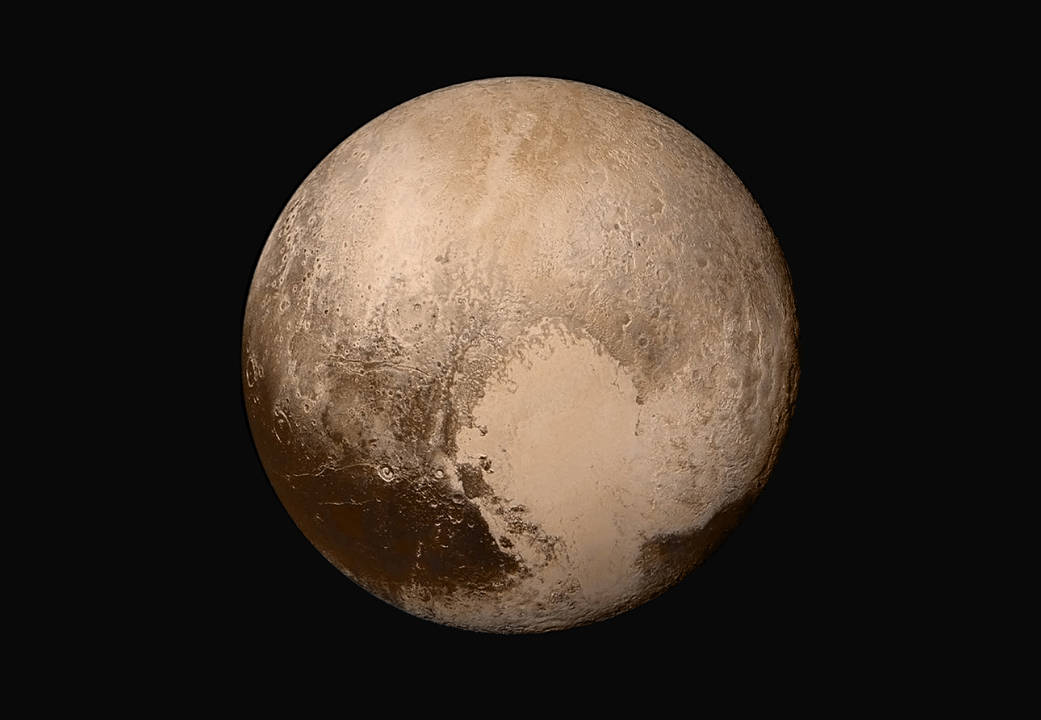
Planets can’t talk. And if planets can’t talk, lowly dwarf planets surely can’t either. But if everybody’s favorite dwarf planet could talk, it would have one thing to say: “How ya’ like me now?”
Pluto has a right to strut (OK, dwarf planets don’t have legs either, but never mind). After being drummed out of the family of fully certified planets in 2006 and busted down to a minor league of orbital rocks, it had long languished in a kind of cosmic ignominy.
But that same year, as it happened, the New Horizons spacecraft was launched, beginning a nine-year journey to Pluto that culminated last July with a close-up fly-by and a stream of stunning photos that sparked a global outpouring of love for—to say nothing of scientific interest in—the little world.
Now, with about 40 percent of the data that came back from the ship having been processed and analyzed, a suite of five papers have been published in the journal Science, revealing that the world that so recently got the back of the solar system’s hand might be one of the most interesting ones of all. Here, in order of coolness—insanely cool down to only slightly less cool—are the top five craziest things the papers reveal about Pluto.

Ice volcanoes: You read that right. Pluto and the largest of its five moons, Charon, are as old as the solar system itself, which goes back about 4.5 billion years. But portions of the surface of both worlds show less cratering and wear than they should. Smooth areas like this are generally younger areas, ones that have been resurfaced in some way. In this case, the resurfacing is likely due to eruptions of water from deep within Pluto and Charon, heated and propelled either by buried radioactive materials, gravitational compression, or tidal interactions between the two worlds. Whatever the cause, when the water explodes into space it flashes into crystals, putting on a brilliant sky show—even if, alas, no one is there to see it.
Floating mountains: Pluto’s most distinct—and lovable—feature is its giant heart-shaped formation, dubbed Tombaugh Basin, after Clyde Tombaugh, the amateur astronomer who discovered the world in 1930. On the far western edge of the basin are mountain-like structures that rise up to 3.1 miles (5 km) above the surface, and give the area a rough, scaly appearance. Unlike the great peaks on Earth, which are capped by ice, these simply are ice—vast blocks that, in the -380º F (-229° C) temperatures of Pluto are far more enduring than our mere rock mountains. Beneath the water ice is a sort of bedrock of nitrogen and carbon monoxide ice. And since those ices are denser than water, the ice mountains float on them like icebergs on water. No matter where you go in the solar system, the physics of float won’t change, even if the chemistry behind it does.
Strange moons: Pluto and Charon are not alone in the Plutonian system. They are easily the largest bodies—Charon is 750 miles (1,207 km) in diameter and Pluto is 1,474 miles (2,372 km). But they are accompanied by four tiny, irregularly shaped moons named Styx, Nix, Kerberos and Hydra, measuring from 15 miles (25 km) to 27 miles (43 km) long. Those little satellites are the wild children of the system, spinning in ways they simply shouldn’t. Most planet-moons systems fall into a kind of gravitational synchrony, with the orbit and rotation of each body constrained and stabilized by all of the others. But the there is no such order in the different—and very fast—spin rates of the four pipsqueak moons. This suggests that the Plutonian system might not be as old as the solar system itself. Instead, Pluto and Charon might have had nothing to do with each other until sometime in the unknown past, when they met in a chance collision that produced the rubble of the four small moons. All of the bodies then joined in the close—if sloppy—orbital dance that endures today.
Plenty of “air”: Small worlds don’t do a good job of hanging onto their atmosphere. Just ask Mars, which once had enough atmospheric protection to support water, but lost nearly all of it to space, thanks partly to its low gravity, which is only 39% of Earth’s. Pluto, with an even more tenuous 6% of our gravity, shouldn’t have a chance. But while its nitrogen, methane and carbon monoxide atmosphere is leaking away, the loss is much slower than astronomers believed. Why? The cold. When Pluto is at its greatest distance from the sun, much the atmosphere actually settles and freezes onto the planet. At greater distances, the atmosphere grows gaseous again, but the new findings show that it’s still too cold to escape as easily as once thought.
A surface in flux: At some point most worlds just stop changing. Our moon may have a small molten core, but it’s buried so deeply that most of the rest of it is just old, cold rock. Something similar is true of Mercury. Pluto, however, appears to have tricks left to it. A hot, liquid, radioactive core has contributed to the world’s ice volcanoes and periodic resurfacing, and may even support plate tectonics. Long fissures across the surface also suggest that the crust of Pluto cracked and tore as a subsurface ocean froze and expanded. We may not get back to Pluto for a long time to come, but if we ever do, we could see a very different place.
More Must-Reads From TIME
- The 100 Most Influential People of 2024
- Coco Gauff Is Playing for Herself Now
- Scenes From Pro-Palestinian Encampments Across U.S. Universities
- 6 Compliments That Land Every Time
- If You're Dating Right Now , You're Brave: Column
- The AI That Could Heal a Divided Internet
- Fallout Is a Brilliant Model for the Future of Video Game Adaptations
- Want Weekly Recs on What to Watch, Read, and More? Sign Up for Worth Your Time
Write to Jeffrey Kluger at jeffrey.kluger@time.com